Managua Travel Guide
The Nicaraguan capital of Managua is the perfect introduction to this Central American paradise. It is an ideal starting point for exploring the country, situated as it is on the banks of Lake Managua and midway between Leon and Granada.
With its name derived from the indigenous Nahuatl language, Managua means 'town surrounded by water'. In recent times, Managua carries a reputation as being the 'Venice of Central America' because of the makeshift canals snaking through the city.
Managua divides into pre- and post-earthquake areas. Two major earthquakes devastated the town in 1931 and 1972, forcing residents to build businesses and residential areas outside of Managua rather than in the centre of town, which still contains older buildings not structurally designed to withstand earthquakes.
The rebuilt Managua does not seem to follow a particular layout system, and shopping malls, residential areas, and parks are scattered throughout the city. Zona Rosa and Metrocentro are the main tourist areas.
The city is the cultural and political hub of Nicaragua. It is also central to trade and industry, as is evident in the frenetic activity and constant buzz. Visitors to Managua will be delighted by the city's combination of old and new, and its natural beauty, surrounded as it is by volcanoes, lakes, mountains, and lagoons.
Getting around in Managua can be tricky because of extensive earthquake damage. Years of major quakes and tremors have left many parts of central Managua without proper addresses or street names.
Using the lake as a point of reference is particularly useful whether travellers are using a hired car, taxis, or public buses. Managua boasts a number of tourist attractions, including the National Museum, National Palace, and the old and damaged Managua Cathedral.
The town has a selection of quaint markets where tourists can buy everything from ethnic mementos and souvenirs to colourful hammocks and paintings. The capital city charms visitors to Nicaragua, who are enthralled by its natural beauty and scenic surroundings.
Things to do in Managua
Managua is an interesting and attractive city, a chaotic mishmash of old and new. While the main challenge is not getting lost, the Plaza de Revolucion is a good starting point for tourists keen on doing some sightseeing because a number of historic buildings ring the square.
The city's damaged cathedral and the National Museum of Nicaragua are musts for those wanting to learn of the country's tumultuous history. Another establishment worth visiting is the Museum of Acahualinca, housing the remarkable fossilised human footprints left 6,000 years ago in the volcanic mud along the shores of Lake Managua.
For something a little more fun and outdoorsy, tourists should head to the Tiscapa Lagoon Natural Reserve, a watery playground with ziplines, canopy tours, bars, restaurants, and shops. Although Managua has some cultural and historical attractions, the city is a favourite with travellers mainly because of the natural beauty on its doorstep.
Excursions are possible to the picturesque colonial city of Granada and the huge Lake Nicaragua, with its volcanic islands begging to be explored. The glorious Montelimar Beach, Nicaragua's most popular beach resort, allows visitors the chance to enjoy the Pacific coastline of this beautiful country.
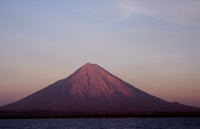
Nicaragua's Volcanoes
No trip to Nicaragua is complete without a hike up at least one of the country's many volcanoes. Nicaragua is home to a remarkable string running from the southern mountains around Lake Nicaragua up to the impressive northern Cosiguina Volcano, towering over the Gulf of Fonseca. Many of the Nicaraguan volcanoes are dormant. However, since some remain active, it is advisable to hike the volcanoes with a guide or local tour group. Some of the more popular volcanoes include Maderas, Concepcion, Zapatera, Mombacho, and Laguna de Apoyo. Maderas, Concepcion, and Zapatera rise up out of Lake Nicaragua. Zapatera stands alone while Maderas and Concepcion are located on Ometepe Island, popular climbing choices for visitors. Concepcion is an active volcano, but Maderas is dormant. Zapatera is not popular among tourists as it is difficult to reach and the volcano itself is both extinct and relatively small at 2,063 feet (629m). Mombacho Volcano lies on the banks of Lake Nicaragua and is thought to be the source of the lake's islands. Mombacho is great for hiking and it's even possible to drive to the top. The beautiful Laguna de Apoyo is a tranquil crater lake popular with hikers and swimmers. The western shore of the lake has an active fumarole emitting steam and gas.
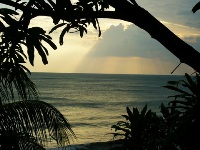
Montelimar Beach
Montelimar Beach sits on the Pacific Coast of Nicaragua, offering tourists the perfect Nicaraguan beach resort experience. It is one of the most beautiful beaches in the country and is the closest to the capital city of Managua, where many travellers begin their Nicaraguan visit. The Barcelo Hotel and Resort on the old Somoza Estate is a great option for those wanting an all-inclusive beach resort getaway, featuring a huge pool, said to be the largest in the country, and even a casino overlooking the sea. For those who prefer to avoid package deals and resorts, there are a few other options for accommodation near Montelimar Beach. The most popular activity in Montelimar is simply relaxing on the 1.5-mile (3km) stretch of beach made up of pristine white sand. Visitors can also enjoy the animals at the nearby zoo, or go shopping at the popular curio stalls and shops dotted throughout the area. Other things to do in this Nicaraguan resort town include scuba diving, surfing, and snorkelling. Montelimar Beach is a must for visitors seeking a stress-free holiday filled with relaxation and sun.
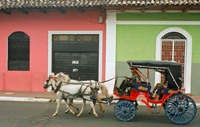
Granada
The colourful city of Granada offers visitors plenty of historical sights and beautiful colonial architecture, some of which dates back to the 1600s. Granada was founded in 1524 and is said to be one of the oldest cities in the New World, a Spanish showpiece that still retains a regal (if dilapidated) charm. Many of the historic buildings have been restored multiple times over the centuries, with residents making an effort to protect their heritage despite pirate invasions and civil wars. The city boasts some lively markets and interesting museums popular with tourists. Granada is home to a vibrant nightlife scene and a number of popular festivals, including the colourful Granada Holy Week festivities. Popular places to visit in Granada include the town's main churches, Parque Central (Central Park), Fuerte La Polvora (an 18th-century fort), Lake Nicaragua, and the Mi Museo (a private museum). Other fun things to do in and around Granada include forest canopy tours, treks around the Masaya Volcano, shopping excursions at the town's local market, and trips to coffee plantations. Granada is the best town for visitors to use as a base while exploring Lake Nicaragua, as well as many of the country's volcanoes and beaches.
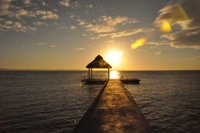
Lake Nicaragua
Sometimes referred to as Lake Cocibolca, Lake Nicaragua is Central America's largest lake and 10th largest body of fresh water in the world. A number of attractions apart from its size make Lake Nicaragua remarkable, spreading out beneath Mombacho Volcano. It is one of the few freshwater bodies in the world that contains sharks. Bull sharks inhabit the depths of the lake and are a rare sight for even the most devoted spotters. Despite the lake's importance in the region, tourist infrastructure isn't necessarily up to standard. Known locally as Las Isletas, the collection of small islands scattered within the lake are believed to be the result of a volcanic eruption thousands of years ago, which spewed massive rocks out into the water. The lake is also home to the volcanic Ometepe Island with its twin volcanic peaks. Visitors to Lake Nicaragua can hire a boat and tour the islands while taking in the spectacular scenery and diverse bird and aquatic life. The cities of Granada, San Carlos, San Jorge, and San Miguelito are all located on the shores of Lake Nicaragua, making it easily accessible for tourists.
National Museum of Nicaragua
The National Museum in Managua is one of Nicaragua's principal tourist attractions and the city's best museum. The museum building sits imposing and attractive on the Plaza de Revolucion, where the ruined cathedral and a number of other important buildings stand. It houses a fascinating selection of artefacts and a number of displays about Central American history, ancient Central American civilisations, and the pre-Columbus period. The museum's nine rooms contain a selection of modern art. There are also informative exhibitions about the country's turbulent natural history, including information about the numerous Nicaraguan volcanoes and earthquakes that have devastated the country over the years. The museum staff are helpful, informative, and friendly, making it an ideal attraction for any visitor wanting to learn more about Nicaragua.
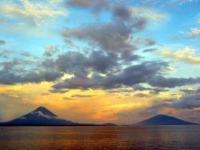
Ometepe Island
The twin volcanoes on Lake Nicaragua are highlights for visitors to the scenic country. Visitors to the islands explore volcanoes by hiking through rainforests, while they can also pay a trip to a local coffee farm that is dependent on the fertile slopes to grow fragrant beans. Birds and wildlife will delight nature lovers, while sports enthusiasts can enjoy kayaking and fishing tours around the island. For those who brave hiking the 5282-foot (1610m) summit of one of the volcanoes, the views are unsurpassed. Visitors could easily spend a few days exploring the numerous natural attractions the islands have to offer. Boats to the islands are available from San Jorge, just outside Rivas, and ferries also depart from San Carlos and Granada. They don't leave every day and are sometimes inactive due to low water levels. The crossing takes roughly 60 minutes and the trip is perfect to take in lake scenery.
Getting Around
The public transport system in Managua consists of buses, taxis, and cycle taxis. Urban buses tend to be old and poorly maintained, although the city's network is fairly extensive. Buses display their route number, and a list of routes is posted on signs for the bus stops.
Despite this, transport information can be scarce and asking locals for assistance is recommended. Interurban buses operate at terminals in the city. There are two main kinds of buses: ordinarios are larger buses with lower fares and longer travel times, while espresos are smaller, more comfortable buses that travel faster but charge more.
Taxis are usually the most convenient means of transport in the city and are widely available. They generally do not have meters and negotiating a fare before setting off is important, especially since they tend to try overcharge tourists.
Managua Climate and Weather
Managua enjoys a tropical climate with temperatures all year round averaging between 80F (27C) and 90F (32C). There is little seasonal variation in temperature, but the hottest months, March and April, are best avoided, as it can get uncomfortably humid.
The year loosely divides into a wet and dry season. Between November and April, the city tends to be dry, with little rainfall. Between May and September, it is rainy and wet. May, June, and October are the wettest months and best avoided, but tropical downpours tend to be brief and bring relief from the heat so some travellers don't mind visiting at this time.
Ideally, visitors to Managua should plan their trip for some time between November and February when the weather is pleasantly warm but not scorching. There isn't too much rainfall but the best time to visit Managua is in November and December.
Some travellers may also want to time their visits to witness the city's best festivals and biggest events, in which case Easter and early August are probably the best bets despite the oppressive heat in April and the possibility of rain in August.
Nicaragua travel info
Electricity
Electrical current in Nicaragua is 120 volts, 60Hz. Flat blade plugs are used.
Language
The official language in Nicaragua is Spanish. Some communities on the Caribbean Coast speak indigenous languages. English is understood at some tourist destinations.
Money
The currency is the Nicaraguan córdoba (NIO). US Dollars can also be used for most common transactions. Bills must be in good condition to be accepted, but damaged bills can be exchanged at banks. All major cities have ATMs and most hotels and restaurants accept credit card payments.
Tipping
Tips are not expected in Nicaragua except with guides and at restaurants, where a tip of around 10 percent is the norm for table service.
Health
Visitors from a yellow fever infected area in the Americas or Africa require proof of their vaccination before entry; all eligible travellers should be up to date with their COVID-19 vaccines. Malaria is a threat in many regions of Nicaragua and travellers are advised to seek medical advice and take some form prophylaxis.
Insect repellent and mosquito nets should be used to avoid malaria and dengue fever, both of which are carried by mosquitos. Recommended vaccinations include ones for hepatitis A, hepatitis B, and typhoid, and for rabies for those coming into contacts with animals, especially bats.
Modern medical facilities in Nicaragua are only found in major towns and cities, the best of which are in Managua. Rural communities lack modern hospitals and equipment, and medications are in short supply. If needing a hospital in Nicaragua, travellers should indicate that they desire a private hospital.
Comprehensive travel insurance is essential and travellers should take along any medication they require in its original packaging, and accompanied by a signed and dated letter from a doctor detailing what it is and why it is needed.
The most common health affliction for tourists is traveller's diarrhoea, which is preventable by safe water and food consumption. Travellers should not drink tap water, and should use common sense when eating uncooked foods.
Safety
Nicaragua is one of the safest countries to visit in the region and most trips are trouble-free. Travellers should avoid taking buses after dark, though, as road conditions are poor and highway driving during these hours is especially dangerous.
Political demonstrations and protests occur sporadically in urban areas and can become violent; tourists should avoid all street gatherings. Also, theft and violent crime are becoming more common in urban areas of the usually safe country. Travellers should be careful of muggings in taxis and only use official taxis with red license plates and the driver's ID above the dash.
Powerful waves and currents can make Nicaragua's beaches dangerous, and swimmers and surfers should exercise caution.
Local customs
A firm handshake for men and a peck on the cheek for women are customary greetings in Nicaragua. Visitors should note that while locals welcome haggling in markets and with street vendors, they don't accept it in shops. It's good manners to use the supplied shot glass to measure a drink when sharing a bottle of rum, rather than pouring freely from the bottle.
Doing business
Business customs in Nicaragua are relatively straightforward, as many Nicaraguan executives were educated in the United States and are familiar with U.S. business etiquette. Business lunches can last longer than one hour and are a good way to build a personal relationship. Indeed, small talk is an essential part of most meetings, though topics such as politics, religion and socio-economic issues are best avoided; foreigners should wait for the host to direct the conversation to business. Meetings tend to end naturally rather than at a set time, and it's considered rude to rush off without staying to chat.
Open-collar attire is acceptable for most meetings, but Nicaraguans who are accustomed to dealing with foreigners may dress more formally. Punctuality is important, though meetings typically begin late. Businesses remain open at midday, but executives may be unavailable between noon and 2pm.
Duty free
Visitors to Nicaragua may import up to 200 cigarettes or 500g of tobacco, five litres of liquor, and five bottles of perfume. Fresh foods, live animals, plants and their products are restricted. Firearms require an import license.
Communications
The international access code for Nicaragua is +505. The outgoing code is 00, followed by the relevant country code (00 44 for the United Kingdom).
Local mobile phone calls are usually cheapest with locally bought SIM cards and public wifi is widely available in all major cities and tourist centres. The country's mobile data network is always improving and works well in big cities, but can be painfully slow in rural areas.
Passport & Visa
Travellers from most western countries do not need to arrange a visa prior to entry. Tourist cards are granted on arrival for USD 10 and are good for stays up to 90 days. Extensions are possible for a fee of USD 2 per day. All visitors must be in possession of onward or return tickets, documents for their destination outside of Nicaragua and evidence of sufficient funds to support themselves for the duration of their stay. There is currently a requirement to have a 'negative COVID-19 RT-PCR Test' certificate or a Full Vaccination Certificate to enter Nicaragua. If entering by air, visitors should check with their airline that they are satisfied that these requirements have been met. It is recommended that tourists have six months' validity remaining on their passports upon arrival in any country.
Entry requirements
Americans require a valid passport, but a visa is not necessary for touristic stays of up to 90 days. A tourist card, costing USD 10, will need to be purchased on arrival.
UK nationals require a passport valid for six months beyond the date of arrival, but a visa is not necessary for touristic stays of up to 90 days. A tourist card, costing USD 10, will need to be purchased on arrival.
Canadians require a passport valid for six months beyond the date of arrival, but a visa is not necessary for touristic stays of up to 90 days. A tourist card, costing USD 10, will need to be purchased on arrival.
Australians require a passport valid for six months beyond the date of arrival, but a visa is not necessary for touristic stays of up to 90 days. A tourist card, costing USD 10, will need to be purchased on arrival.
South Africans require a passport valid for six months beyond date of arrival, but a visa is not necessary for touristic stays of up to 90 days. A tourist card, costing USD 10, will need to be purchased on arrival.
Irish nationals require a passport valid for six months beyond date of arrival, but a visa is not necessary for touristic stays of up to 90 days. A tourist card, costing USD 10, will need to be purchased on arrival.
New Zealand nationals require a passport valid for six months beyond arrival, but a visa is not necessary for touristic stays of up to 90 days. A tourist card, costing USD 10, will need to be purchased on arrival.
Useful contacts
Nicaraguan Institute of Tourism, Managua, Nicaragua: +505 2254 5191 or www.visitanicaragua.com/ingles
118 (Police) and 115 (Fire)Embassies / consulates in other countries
Embassy of Nicaragua in Washington DC, United States: +1 (202) 939 6570.
Embassy of Nicaragua, London, United Kingdom (also responsible for Ireland): +44 (020) 7938 2373.
Nicaraguan Embassy, Ottawa, Canada: +1 (613) 252 5880.
Embassies / consulates in Nicaragua
US Embassy, Managua: +505 2252 7100.
British Embassy San Jose, Costa Rica (also responsible for Nicaragua): +506 2258 2025.
Canadian Embassy, San José, Costa Rica (also responsible for Nicaragua): +506 2242 4400.
South African Honorary Consulate, Managua, Nicaragua: (+505) 2270 5634.


